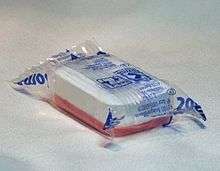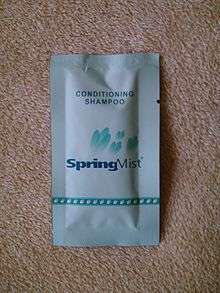Packet (container)



A packet is a small bag or pouch, made from paper, foil, or plastic film, often used to contain single-use quantities of foods or consumer goods such as ketchup or shampoo. Packets are commonly opened by making a small rip or tear in part of the package, and then squeezing out the contents.
Uses
Condiments distributed in packets include ketchup, mustard, mayonnaise, salad cream, HP sauce, relish, tartar sauce, vinegar and soy sauce. They provide a simple and low-cost way of distributing small amounts of condiment with ready-to-eat packaged food such as hot dogs, French fries, or hamburgers, and are common in fast food restaurants. The packets produce less contamination and mess than freely available condiments dispensed into small disposable cups or other containers, especially if the food will be in transit before dining. Potpourri fragrances are also sold in sachets. Potpourri sachet envelopes are filled with scented herbs and flowers or use vermiculite containing aromatic fragrance oil. These are known as potpourri wardrobe sachets. In Argentina and Uruguay, milk and yogurts are also sold in packets.
In 1983, the Indian company Cavin Kare began selling shampoo in small plastic packets instead of large bottles in order to make it more affordable to the poor.[1] Sale of small amounts of shampoo and detergents in plastic packets is very popular throughout the Philippines, India and other Eastern countries.[2] In 2011, 87% of shampoo sold in India was in sachets.[3]
History
Benjamin Eisenstadt invented a machine that produced the modern sugar packet after a failed endeavor to package and sell tea bags, later packaging other items, including sauces.[4]
Variants
The Sanford Redmond designed the no mess dispenSRpak for one handed operation. Introduced into Australia in 1990, it is used in other countries, but the design has not been widely licensed in the USA.[5][6][7][8]
In 2010, the H. J. Heinz Company designed a new ketchup packet. The new design was made with a cup and easy tear, thus making it easier to dip food without a plate along with holding three times as much ketchup.[9][10] It has not been widely adopted.[11]
Records
In Collinsville, Illinois, the largest ketchup packet was created by H. J. Heinz Company for a fundraiser for the Collinsville Christian Academy. People could buy a bottle of ketchup for $1 to add to the ketchup packet. After it was filled, it weighed 1,500 lbs. and it was 8 ft × 4 ft (2.4 m × 1.2 m) across and 9.5 in (240 mm) thick.[12][13]
Annual production of ketchup packets by Heinz alone is 11 billion.[14]
See also
References
- ↑ "The inspiring success story of CavinKare". Rediff-India. 22 March 2007.
- ↑ "Packaging preferences". Archived from the original on 2012-03-01.
- ↑ "Now aiming at the high end". Business Today. India. 30 October 2011.
- ↑ "Why are ketchup packets so... unsatisfying?". marketplace.org.
- ↑ "Sanford Redmond". Sanford Redmond. Retrieved 2012-11-13.
- ↑ Hesser, Amanda (2000-07-30). "BUSINESS; Man Behind the Butter Pat Now Lets You Hold the Mayo, One-Handed". The New York Times.
- ↑ "91/50 Packaging, (2), food, tomato sauce, plastic, 'Masterfoods Squeeze Mate', Australia, made by Conoflex packagiing, designed by Sanford Redmond, 1990 - Powerhouse Museum Collection". Powerhousemuseum.com. 2012-01-31. Retrieved 2012-11-13.
- ↑ Martin, Douglas (1989-12-16). "About New York; Of Metaphysics And the Making Of Useful Things". The New York Times.
- ↑ "New Ketchup Packet Allows for Dunking or Squeezing". ABC News. 2010-02-04. Retrieved 2010-07-08.
- ↑ "Old Ketchup Packet Heads for Trash". wsj.com. 19 September 2011.
- ↑ "Why are ketchup packets so... unsatisfying?". marketplace.org.
- ↑ "Heinz Ketchup Packet to Squeeze Into Guinness Book History", Business Wire, July 27, 2007
- ↑ "Ill. town creates record ketchup packet". Usatoday.Com. 2007-07-28. Retrieved 2010-07-08.
- ↑ "Trivia". Heinz. Retrieved 26 January 2016.
Further reading
- Yam, K. L., "Encyclopedia of Packaging Technology", John Wiley & Sons, 2009, ISBN 978-0-470-08704-6
